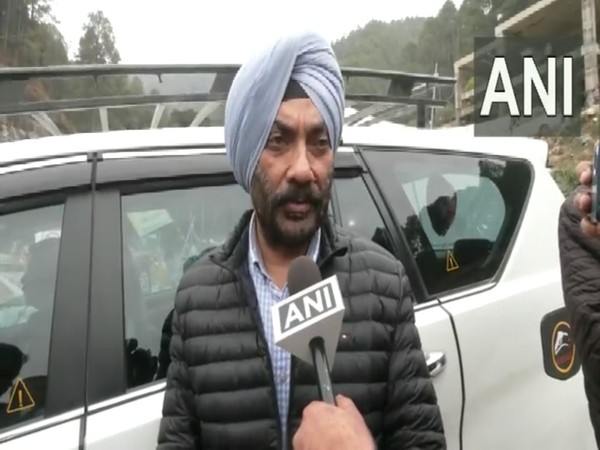Uttarakhand tunnel rescue: Former Army Engineer-in-Chief vouches for manual method to reach trapped labourers
As the vertical drilling makes swift progress, former Engineer-in-Chief and Director General of Border Roads Organisation, Lieutenant General (retired) Harpal Singh said that there is no other way left except the manual method to reach the trapped workers in the Silkyara tunnel.

- Country:
- India
As the vertical drilling makes swift progress, former Engineer-in-Chief and Director General of Border Roads Organisation, Lieutenant General Harpal Singh (Retd) said that there is no other way left except manual method to reach the trapped workers in the Silkyara tunnel. "There is no other way left except the manual method and this is also the safe one through which we can reach the labourers. In the current situation, the Auger machine that was stuck has been removed. Efforts are underway to remove the 1.5 meters of the damaged pipe. After its removal, strengthening and muck clearance, skilled labourers will go in with the help of the army. We hope this will be done soon," Lt. Gen Harpal Singh (retd) said.
Singh said that he reached the site to provide technical inputs and further aid the ongoing rescue operations. He added that efforts are made on all fronts to speed up the rescue process. "I have come here to provide technical inputs and participate in further rescue operations. The work which is being done through the pipeline from below and also the work which is being done through vertical drilling from above which has been done around 31 meters, efforts are being made through both the routes," he said.
Speaking further on the manual drilling to be undertaken, he said, "We are here to assist, the operations are carried out by the Army and also other agencies. We all are working together. The works are done under the leadership of the Secretary of the Ministry of Road, Transport and Highways (MoRTH)." "The Engineers Regiment of the Army has made a manual drift and along with them the people of the Engineer Regiment will work on laying the last 10-12 metre pipeline," he added.
A unit of Madras Sappers, an engineer group of the Corps of Engineers of the Indian Army was called in on Sunday for manual drilling at the site. Thirty personnel of the engineer regiment are at the spot to expedite the rescue operations.
Lt. Gen Harpal Singh (Retd) further outlined that the safety of those working in the rescue is also important adding that all safety measures are undertaken in this regard. "Our people are also taking care of the safety measures of those who will go inside for manual drilling. Safety is our priority. The people working should all be safe. This is our first priority. They have been provided an oxygen facility inside the pipeline and oxygen will be supplied to those who are working," he added.
As per official sources, the rat hole mining technique will be used through manual drilling to remove the debris inside the pipe to accelerate the rescue. The rat hole mining technique is generally used in coal mining, especially in regions that have difficult terrain.
A team of 6 labourers have reached the site to undertake the manual drilling work and a team of 11 people will go inside the 800 mm pipe of the tunnel to remove the debris manually. The team includes engineers from the Indian Army's Madras Engineering Group as well as civilians. Apart from the drilling machine, a hammer, a shovel, a trowel, and a life support device for oxygen will be carried by these specialised teams while going inside the tunnel.
The auger machine being used for horizontal drilling of the tunnel that got stuck inside the pipe was cut and removed earlier today using a plasma cutter. The auger machine stuck inside the pipe produced 48 m of debris on the mouth of the tunnel, which will also be removed by the rat miners. "It is a challenging operation. We were called in from Delhi. We reached here yesterday. We are basically from Madhya Pradesh. We will try our best to complete the drilling process as soon as possible," one of the specialists who reached the site to carry out manual drilling told ANI.
Meanwhile, SJVN, a public sector undertaking company involved in hydroelectric power generation and transmission, started the vertical drilling work on the top of the tunnel atop the hill on Sunday, November 26. Over 31 metres of vertical drilling, work have been completed so far out of the 86 metres needed to reach the trapped workers.
As per National Highways and Infrastructure Development Corporation Limited (NHIDCL), the drilling work is expected to be completed by November 30, as the agencies have set a time frame of 100 hours i.e. four days. In collaboration with the Border Road Organisation and other agencies, efforts are underway to enter from the other mouth of the tunnel that is the Barkot side. Four blasts were undertaken under the supervision of BRO and so far only 10 metres out of 500 meters have been covered.
Also, the rescuers are planning to build a mini tunnel along the left side of the tunnel, horizontal but perpendicular to the Silkyara tunnel, the work of which will be undertaken by SJVN. After a portion of the tunnel caved in on November 12, the debris falling in the 60-metre stretch on the Silkyara side of the tunnel trapped 41 labourers inside the under-construction structure. (ANI)
(This story has not been edited by Devdiscourse staff and is auto-generated from a syndicated feed.)
ALSO READ
Tragic Fire in Delhi Furniture Factory Claims Two Lives
Delhi Chokes Under 'Very Poor' AQI: Urgent Action Required
Major Setback for Terrorist Groups in Anantnag: Indian Army Neutralizes Two Suspects
New Delhi Hosts Inaugural Asian Buddhist Summit to Promote Unity
Tragic End: Woman Found Dead in Delhi Home










